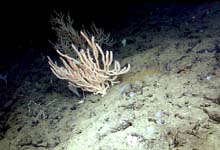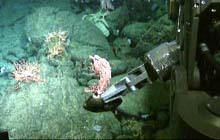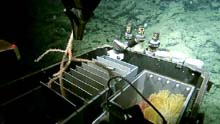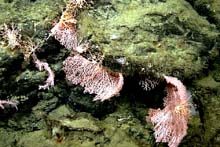
Bamboo coral can live to be more than 200 years old. Note the faint red laser dots on this image, located at the "four o'clock" and "ten o'clock" positions. The dots give us a measurement scale (29 cm) for everything we collect. Click image for larger view and image credit.
The remotely operated vehicle (ROV) manipulator arm adds bamboo coral to the bio box on the ROV sled. The bamboo coral samples are placed in the slotted section so researchers can tell one individual from another. Other species are put into the larger box (at the right). Numbered push-cores on the front of the drawer are used to collect sediment samples. Click image for larger view and image credit.
Recovering Coral Samples
January 29, 2006
Allen Andrews
Radiochemist
Moss Landing Marine Laboratories
California State University
As we "flew" the remotely operated vehicle (ROV) Tiburon from the floor of "Big Valley" up a slope of jumbled basaltic (lava) rock, we came upon small stands of bamboo coral. I was excited to see them, because collecting samples of this large coral is my main objective on this expedition. Prior to sampling the bamboo colonies, we took a series of photographs of each colony. In each photograph, we placed a set of lasers separated by a known distance — 29 cm, in this case. The lasers will allow us to determine the size of the colonies prior to sampling. I wanted to get two small branches from each colony, which we accomplished using the ROV's robotic arm to carefully reach in and snap off a small limb. Each limb was placed in a special file-like box to keep track of the colony and the location from which the sample came. Today, we managed to collect samples from four colonies in two different locations. Over the next few days, I plan to sample in the same manner at two more locations on Davidson Seamount.
In addition to collecting bamboo coral samples, I am interested in other coral species. Specifically, I did some age and growth work on a pink coral (Corallium sp.) colony collected in 2002 from Davidson Seamount. I determined that this 30 cm colony was more than 120 years old, and it could be as old as 200 years. While searching for bamboo corals yesterday, we discovered that pink coral is very common on a hill we later called "Corallium Cap." Here we carefully collected a full pink coral colony attached to a rock. This coral is very brittle, but the ROV pilots handled the sample with skill, collecting it intact. This specimen is currently stored in the freezer and will undergo more precise age determinations back at my lab at Moss Landing Marine Labs.

The ROV pilots used the manipulator arm to pick up this colony of pink coral still attached to a rock — without breaking any branches. The manipulator claw is about 9-in long, but the skilled ROV pilots can pick up items as small as a dime from the sea floor. Click image for larger view and image credit.
Sign up for the Ocean Explorer E-mail Update List.






















